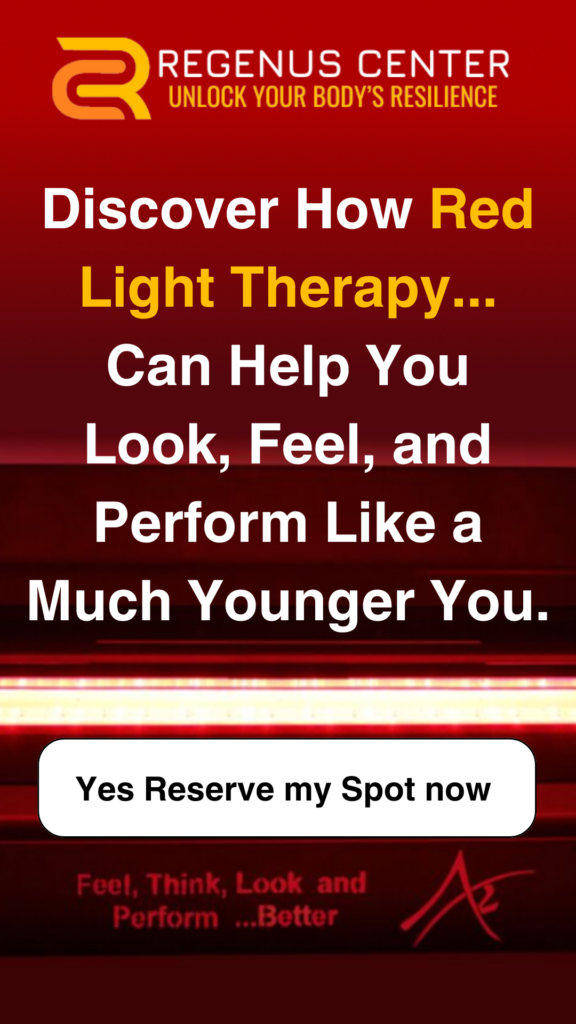Red light therapy (RLT) at Regenus Center, East Hanover, NJ, also known as low-level light therapy (LLLT), is an emerging treatment option for various health conditions, including chronic pain and inflammation. When it comes to migraines, a debilitating type of headache that often involves intense, throbbing pain and sensitivity to light, red light therapy has shown some promise in scientific research as a potential treatment. However, its effectiveness is still being explored, and it is not yet a mainstream treatment for migraines.
How Red Light Therapy Helps Migraines?
Red light therapy uses low-wavelength red and near-infrared light to penetrate the skin and underlying tissues. The light stimulates the mitochondria in cells, increasing energy production (ATP) and promoting cellular repair. In the context of migraines, several mechanisms could potentially contribute to pain relief:
- Reduction of Inflammation: Migraines are often associated with neuroinflammation, especially in the blood vessels and nerves of the head. Red light therapy has been shown to reduce inflammation by downregulating pro-inflammatory cytokines and increasing the activity of anti-inflammatory agents. This could help reduce the inflammatory triggers that contribute to migraine attacks.
- Improved Blood Circulation: One theory behind migraine pain is that it is related to poor blood circulation and vasodilation (the dilation of blood vessels). Red light therapy has been shown to improve microcirculation, which may help reduce the vascular issues contributing to migraine onset.
- Modulation of Pain Pathways: Red light therapy has been studied for its ability to modulate pain pathways by promoting the release of endorphins, the body’s natural pain relievers. This pain-relieving effect could potentially be helpful in managing the intensity of migraines.
- Relaxation and Stress Reduction: Migraines can also be triggered by stress and muscle tension, particularly in the neck and head areas. Red light therapy’s ability to reduce muscle tension and promote relaxation may indirectly help prevent stress-induced migraines.
Is Red Light Therapy Effective for Migraines?
There is some research supporting the potential use of red light therapy for migraines, although more studies are needed to fully confirm its effectiveness.
A 2016 study published in Pain Research and Management examined the effects of low-level light therapy on patients with chronic migraines. The study found that those who received red light therapy experienced a reduction in the frequency and severity of their migraine attacks. Patients also reported shorter duration of migraine episodes after undergoing several sessions of red light therapy. These findings suggest that RLT may help reduce the impact of migraines, though the precise mechanisms remain unclear.
In another study from 2018 published in Journal of Headache and Pain, researchers investigated the use of light therapy, including red light, to alleviate symptoms of headaches and migraines. The study showed a reduction in inflammation of the trigeminal nerve—a major pain pathway involved in migraines—when patients were exposed to red and near-infrared light. This reduction in nerve inflammation contributed to lower pain levels and fewer migraine episodes over time.
Benefits of Red Light Therapy for Migraines
- Non-Invasive and Drug-Free: Red light therapy is a non-invasive treatment with minimal side effects, making it a promising alternative for those seeking drug-free migraine relief.
- Potential for Long-Term Relief: By addressing underlying issues such as inflammation, poor circulation, and nerve irritation, red light therapy may offer more lasting relief from migraines compared to treatments that only address symptoms.
- Complementary to Other Treatments: RLT can be used alongside other migraine management strategies, such as medications, lifestyle changes, and stress-reduction techniques.
- Minimal Side Effects: Red light therapy is generally well-tolerated with few reported side effects, which is advantageous for migraine sufferers who may be sensitive to certain medications.
Limitations and Considerations
While red light therapy shows promise, it is not yet a widely accepted treatment for migraines, and more clinical trials are needed to confirm its efficacy. The treatment may not be suitable for all types of headaches or migraines, as each person’s triggers and symptoms can vary. For example, those who experience migraines triggered by light sensitivity (photophobia) may need to approach light therapy with caution, as light exposure during a migraine attack could potentially exacerbate symptoms.
Furthermore, red light therapy is most effective when used consistently over time, and results may not be immediate. The optimal wavelength, duration, and frequency of treatment for migraines have not yet been standardized, which makes it important for individuals to work with a healthcare provider to determine a personalized treatment plan.
Conclusion
Is Red light therapy effective for migraines? The answer is yes; this therapy holds promise as a non-invasive treatment option for migraines. RLT may help decrease the frequency and severity of migraine attacks by reducing inflammation, improving circulation, and modulating pain pathways. While initial studies have shown positive results, more research is needed to establish red light therapy as a mainstream treatment for migraines. For those seeking alternative or complementary treatments, Red Light Therapy at Regenus Center, East Hanover, NJ, may be worth considering under medical supervision, especially for individuals looking to reduce their reliance on medications.
Keywords: Red light therapy, migraines, chronic headaches, low-level light therapy, inflammation reduction, pain relief, phototherapy, non-invasive treatment, migraine management.
References:
- Zare, Z., Nikbakht, M., & Davoudi, M. (2016). Effect of low-level laser therapy on chronic migraine: A pilot study. Pain Research and Management, 2016, 1-8.
- Kowacs, P. A., Piovesan, E. J., & Duarte, J. (2018). Phototherapy for migraine and tension-type headaches: A randomized, double-blind trial. Journal of Headache and Pain, 19(1), 62.



